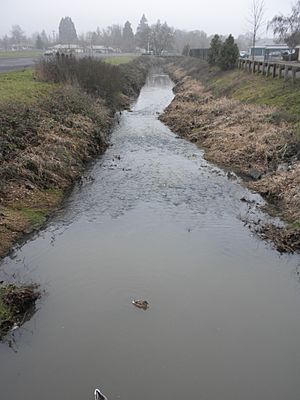Amazon Creek facts for kids
Quick facts for kids Amazon Creek |
|
|---|---|

Along the creek
|
|
|
Location of the mouth of Amazon Creek in Oregon
|
|
| Country | United States |
| State | Oregon |
| County | Lane |
| Physical characteristics | |
| Main source | near Spencer Butte Eugene 1,079 ft (329 m) 43°59′19″N 123°05′02″W / 43.98861°N 123.08389°W |
| River mouth | Long Tom River west of Junction City 318 ft (97 m) 44°13′39″N 123°15′49″W / 44.22750°N 123.26361°W |
Amazon Creek is a stream that flows through the city of Eugene, in the United States. It's a smaller river that eventually joins the Long Tom River. Amazon Creek is the second-largest waterway in Eugene, after the Willamette River.
Contents
About Amazon Creek
Amazon Creek starts in the hills southeast of Eugene, near a place called Spencer Butte. The very beginning of a river is called its headwaters. Over time, people have changed how the creek flows. It now travels north from Martin Street, going through Amazon Park in a special channel.
When it reaches 24th Street, the creek enters a long concrete channel, about 1.75 miles (2.8 kilometers) long. It continues north to 18th Avenue, then turns west near High Street. From there, it flows into a special channel called a diversion canal near the Lane County Fairgrounds. This canal helps control the water. The creek then keeps flowing west until it reaches Fern Ridge Reservoir and the Long Tom River.
Why Amazon Creek is Important
Amazon Creek collects water from a large area of Eugene, about 21 square miles (54 square kilometers). This includes water from city streets and storm drains. It's very important for:
- Flood Control: It helps manage rainwater and prevent flooding in the area.
- Wildlife Habitat: Many different plants and animals live along the creek.
- Recreation: People can enjoy parks and natural areas near the creek.
History of Flood Control
In 1946, the United States Army Corps of Engineers (a group that builds and manages waterways) started a big project. They made the creek wider, deeper, and changed its path in a diversion canal. This was done to help control floods. The project was finished in 1958. The canal was designed to handle large amounts of water, even during a "25-year flood" (a flood that has a 1 in 25 chance of happening in any given year).
Protecting the Creek
Today, there are efforts to restore parts of Amazon Creek. This means making the creek wider in some places and planting native plants along its banks. The City of Eugene has named Amazon Creek a "natural area." This is because these areas are home to many different plants and animals, including some that are rare or endangered. These natural areas also provide important ecosystem services, which are benefits that nature gives us, like clean water and places for wildlife to live.


